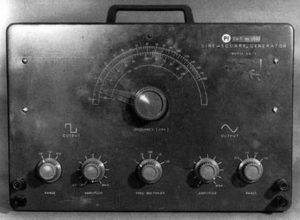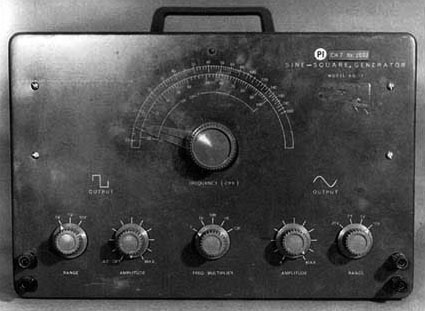
In 1952, 1954 and 1956 Teresa Rampazzi attends the Darmstadt International Summer Courses for New Music. During the 1952 edition she has the chance to hear Herbert Eimert’s speech, where he presents the equipment from the Studio for Electronic Music of the West German Radio in Cologne. Teresa is 37 years old, she still is an avant-garde pianist, but it is a small electronic instrument (a frequency generator) that strikes her. She understands that sound synthesis is the only way to go beyond the rigidity of tonal music. In her own words:
…I arrived at electronic music exactly at its birth, listening to its cries in the large Marienhöhe concert hall, in Darmstadt. (Actually the term ‘arrived’ is not correct because we never actually arrive anywhere, we are always on our way). […] So in that [Marienhöhe] Concert Hall, for the first time Eimert showed the public a small frequency generator. Musicians looked at it suspiciously and did not attach too much importance to it. For me, that little, insidious object would certainly grow, multiply and change [1].
1952 Ferienkurse edition is also one of the most famous editions: Boulez declares the “death” of Arnold Schoenberg’s aesthetics, the new generation of composers –Luciano Berio, Pierre Boulez, Karel Goeyvaerts, Bruno Maderna, Luigi Nono, Karlheinz Stockhausen, Bernd Alois Zimmermann – starts to claim the musical world’s attention. (and Teresa is for the occasion a member of the chorus of España en el corazón by Luigi Nono) [2].
The Electronic Music Studio at Westdeutscher Rundfunk (WDR) in Cologne was founded by the composers Werner Meyer-Eppler, Robert Beyer, and Herbert Eimert. EImert was also the studios first director. To read more on Herbert Eimert and the WDR Electronic Music Studio visit 120years.net
- [1] Teresa Rampazzi, “Piccolo discorso con Michela”, Autobiografia della musica contemporanea (Michela Mollia ed.), Cosenza, Lerici, 1979, pp. 122-126.
-
[2] Antonio Trudu, La “scuola” di Darmstadt. I Ferienkurse dal 1946 a oggi, Milano, Ricordi-Unicopli, 1992, pp. 73-82.
